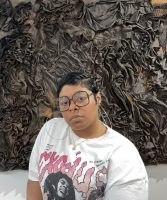CAA News Today
Register for CAA Summer Publishing Webinars!
posted by CAA — June 24, 2024
This summer, CAA will hold webinars in response to an influx of requests for guidance on and advice about academic publishing. Organized and moderated by Christy Anderson, Editor-in-Chief of The Art Bulletin and professor of the History of Architecture at University of Toronto, a panel of publishing experts will discuss and answer audience questions on the topics of turning longer research into an article and responding to readers reports and revisions. Our aim is to help demystify the academic publishing process, expand access to publishing education and professional development, and ultimately increase diversity in publishing.
July 31, 2–4 p.m. ET
In Print: From the Archive to the Essay
Getting Your Research Into Print
Shaping a large amount of research into a powerful essay can be more difficult than writing a book. A successful article needs a strong argument, clear organization, and effective use of images. In this workshop we will discuss some guidelines on developing an essay for The Art Bulletin or other journals. Join Christy Anderson, the Editor-in-Chief of The Art Bulletin and other scholars for a roundtable discussion with time for your questions.
August 7, 2–4 p.m. ET
Contending with Critique: How to Effectively Respond to Readers’ Reports
Each essay in The Art Bulletin has been through multiple revisions in response to comments from readers and the editor. If you are asked to ‘revise and resubmit’ how do you respond to readers’ reports? This workshop will demystify the peer review process and help you to incorporate the best of the advice into your writing.
Publishing webinars are free for CAA members and students.
Non-member registration is $15 per webinar or $20 to register for both.
Not currently a member of CAA? Join for $8 per month to attend both summer publishing webinars for free and receive discounted CAA Annual Conference registration!
Publishing webinars sponsored in part by:

CWA Picks: Summer 2024
posted by CAA — June 07, 2024
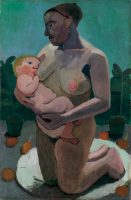
Paula Modersohn-Becker, Kneeling Mother with Child at Her Breast, 1906
(image ©Paula-Modersohn-Becker-Stiftung; provided by Bremen/Nationalgalerie, Berlin)
The CAA Committee on Women in the Arts (CWA) curates a seasonal list of must-see exhibitions, screenings, projects, and talks. The CWA Summer 2024 picks highlight individual artists’ observant and expressive art practices that reveal personal and collective stories about the earth, the environment, communities, and members of lesser known, historically marginalized groups.
UNITED STATES
ACCESS: An Ordinary Notion
June 15–July 13
Arc Gallery, San Francisco
ACCESS: An Ordinary Notion, a national juried exhibition, is proud to present artworks that tell individual stories and advocate for social justice and human rights. Inspired by Alice Paul, who introduced the Equal Rights Amendment in 1923, this collection showcases art in all media that illuminate the ongoing conversation around race, women’s and LGBTQIA+ rights, reproductive rights, disparities in global wealth, power, access to food, water, shelter, education, health services, disability access, child and elder care, along with immigration issues, climate change, and criminal (in)justice.
Beate Kuhn: Turn
June 29–December 1
Carnegie Museum of Art, Pittsburgh
Beate Kuhn (1927–2015) was a German sculptor known for her rhythmic ensembles of deconstructed, ceramic forms such as discs, cylinders, cones, and spheres. She also channeled beautiful and sublime aspects of nature with formal allusions to succulents, seeds, mushrooms, and invertebrate animals. Like the atonal music she favored, Kuhn’s sculptures were both alluring and disquieting.
Calida Rawles: Away with the Tides
June 27–February 23, 2025
Perez Art Museum Miami
Calida Rawles envisions water as a space for Black healing. Merging hyperrealism, poetic abstraction, and the symbolism of water, Rawles creates unique portraits of Black bodies submerged in and interacting with bodies of water. Water functions as an element that signifies both physical and spiritual healing, as well as historical trauma and racial exclusion. Rawles delves into the particular experience of Black people in Overtown, a Miami neighborhood that went from a cultural and commercial hub for Black people to a subject of gentrification, systemic racism, and mass displacement. Rawles photographs some of her subjects in natural waters at Virginia Key Beach, which was once racially segregated. Rawles probes the Atlantic’s history as the site of the transatlantic slave trade. The work critically engages with Miami’s water-entwined climate and mines Overton’s history of beauty, oppression, and resilience.
Jen Liu: GHOST__WORLD
Through August 24
/ (Slash), San Francisco
Jen Liu: GHOST__WORLD features new videos, augmented reality, paintings, and glass sculptures. GHOST__WORLD originates in Liu’s long-term engagement with labor activism and women electronics workers in South China. This project takes up last year’s social media phenomenon of “frog mothers,” unlicensed street vendors in China wearing inflatable frog costumes and selling frog-shaped balloons.
Jennifer Rochlin: Paintings on Clay
Through July 12
Hauser & Wirth, New York City
Rochlin’s three-dimensional compositions coalesce largely without planning. Sketched in advance, the shapes of her vessels ultimately depart from classical form and symmetry through a laborious hand-building process that encourages distortion. The vessels’ physicality prompts viewers to trace their curves and walk around them to follow the sequence of vignettes that travel their circumferences.
LaToya Ruby Frazier: Monuments of Solidarity
Through September 7
MoMA, New York
LaToya Ruby Frazier: Monuments of Solidarity highlights the artist’s role as a social advocate and connector of the cultural and working classes in the twenty-first century. For this exhibition, Frazier has reimagined her diverse bodies of work as a sequence of original installations that she calls “monuments for workers’ thoughts,” which address the harmful effects of industrialization and deindustrialization, the healthcare inequities facing Black working-class communities in the Rust Belt, the ongoing water crisis in Flint, Michigan, and the impact of the closure of a General Motors plant in Lordstown, Ohio. Monuments of Solidarity celebrates the expressions of creativity, mutual support, and intergenerational collaboration that persist in light of these denials of labor, human, and civil rights. As a form of Black feminist world-building, these nontraditional “monuments” demand recognition of how women and people of color have contributed and continue to contribute to histories of labor and the working class.
Leilah Babirye: We Have a History
June 22–June 22, 2025
de Young Museum, San Francisco
Leilah Babirye is known for her ambiguously gendered sculptures in ceramic, wood, and discarded objects. Reclaiming ceramic and wood-carving traditions from western and central Africa, she creates her ceramics by hand, firing them with glazes, while she whittles, scorches, and burnishes her wood sculptures. She then adorns them with wire, bicycle chains, inner tubes, and other found materials. The sculptures, which range in scale from towering totemic forms to busts, talismans, and masks, are portraits of her LGBTQ+ community. Babirye’s work speaks to the power of reclaiming personal and cultural identity through artistic practices, historical narratives, and cultural traditions.
Nampeyo and the Sikyátki Revival
Through September 15
de Young Museum, San Francisco
During her lifetime, Nampeyo (ca. 1860–1942) was, and remains today, perhaps the most renowned potter from the American Southwest. The single-gallery exhibition highlights Nampeyo’s work, juxtaposed with examples of Hopi pottery from her time. Exquisite ceramics made by ancestral Hopi artists demonstrate Nampeyo’s sources of inspiration, and artworks by four generations of her descendants attest to the master potter’s enduring legacy.
Nina Chanel Abney: LIE DOGGO
Through October 5
The School | Jack Shainman Gallery, Kinderhook, NY
LIE DOGGO spans Nina Chanel Abney’s creative practice, uniting a new series of paintings with collages, site-specific murals, an immersive digital art installation, and the debut of a new body of sculpture. Paying homage to the sophisticated color theories of Matisse, continuing the legacy of cubists, and connecting with the sensibilities of Harlem Renaissance greats Douglas and Lawrence, Abney brings these historical movements into contemporary pertinence. The exhibition’s title, LIE DOGGO, a phrase meaning to remain inconspicuously in wait, suggests a strategic invisibility and biding one’s time, reflecting on when to observe and when best to act. Abney challenges the viewer to explore the vast expanse that lies between what is said and what remains silent.
Paula Modersohn-Becker: Ich Bin Ich / I Am Me
June 6–September 9
Neue Galerie, New York City
+
October 12–January 12, 2025
The Art Institute of Chicago
Paula Modersohn-Becker (1876–1907) is a major figure in the history of German Expressionism. In the course of her brief career – which was cut short at the young age of 31 because of a postpartum embolism – Modersohn-Becker produced more than 700 paintings and over 1,000 drawings. She created many self-portraits, including the first nude self-portraits known to have been made by a woman. Many of these works focused on her pregnancy, another first among Western women artists. The artist first became known in part through her letters and diaries, including correspondence with her close friend, the German poet Rainer Maria Rilke. The exhibition is the first collaboration between Neue Galerie New York and the Art Institute of Chicago, to which the exhibition will travel following its debut at the Neue Galerie.
Simone Leigh
Through January 20, 2025
LACMA and the California African American Museum, Los Angeles
This exhibition is the first comprehensive survey of Leigh’s work. Twenty years of the artist’s production across ceramics, bronze, video, and installation are displayed in a show organized by the ICA Boston and co-presented by LACMA and the California African American Museum. Leigh’s practice, which regularly explores the interiority of Black femme life, can be seen in all its iterations at this latest exhibition, including pieces from the artist’s 2022 Venice Biennale presentation.
Samia Halaby: Eye Witness
June 29–December 15
Eli and Edythe Broad Art Museum, Michigan State University, East Lansing
Samia Halaby: Eye Witness follows Samia Halaby’s creative journey to experiment with how painting conveys her experiences and reflects how she sees the world around her. Halaby’s paintings, which range from miniature to monumental, 2D to 3D, and monochrome to multicolor, are notably shaped by her experiences and shift accordingly throughout her itinerant career across the Midwest, the East coast, and the Arab world. Halaby also explores how technology can enhance and transform painting. Halaby’s paintings reflect the life of a witness, one we are invited to take part in by looking slowly and closely at the artist’s work.
Sonya Clark: We Are Each Other
Through September 22
Museum of Arts and Design (MAD), New York City
Highlighting thirty years of artmaking dedicated to the Black experience in America, Sonya Clark: We Are Each Other is the first comprehensive survey of the communal art projects that form the heart of the artist’s pioneering creative practice. Accompanied by a selection of Clark’s photographs, prints, and sculptures, the exhibition features five of Clark’s large-scale, collaborative projects, including her barrier-breaking The Hair Craft Project (2014) and the ongoing performance, Unraveling.
Tanya Lukin Linklater: Inner blades of grass (soft) inner blades of grass (cured) inner blades of grass (bruised by the weather)
Through August 21
Wexner Center for the Arts, Ohio State University, Columbus
Lukin Linklater’s perception of time and place comes across in her sculpture, installation, rehearsals, video, works on paper, and writing. Her practice is inspired by her upbringing in the Kodiak archipelago of Alaska. The exhibition’s title is informed by an interview with the late Sugpiaq cultural worker Eunice von Scheele Neseth and a poem by Oglala Lakota poet Layli Long Solider. Describing grass in different states references the procedures that women of Kodiak Island follow when harvesting and processing plant material used to weave baskets. The imagery evoked by the words also asks viewers to consider observation and touch in the acts of restoration and repair.
Tolia Astakhishvili: between father and mother
Through August 12
Sculpture Center, Long Island City, New York
For more than two decades, Tolia Astakhishvili has worked across sculpture, drawing, painting, sound, and video. At scales that both augment and seemingly disappear into gallery spaces, Tolia’s environments posit architecture as an unfixed and transforming entity shaped by those who live through it. At the same time, her sculpture attends to disavowed space and the overlapping markers of use, authorship, and social position that produce different settings of decay.
Lynn Hershman Leeson: Moving-Image Innovator
Film series
Through June 20
MoMA, New York
Over five decades, Lynn Hershman Leeson has produced work that probes and plays with the complex relationship between humans, technology, and social structures. Her videos navigate the fluid space between perception and truth, exposing our collective and individual biases. The immediacy and urgency of video allowed her to assume an artist-as-activist stance, portraying the lives of women who were barely visible in the moving-image art scene of the time. This retrospective features Hershman Leeson’s complete, four-part “Cyborg Series,” including Cyborgian Rhapsody – Immortality (2023), which was written, performed, and designed by an artificial intelligence chatbot. A special conversation on June 8 brings together Lynn Hershman Leeson, Eugenia Kuyda, founder of the Replika AI app, and the chatbot named Echo.
- June 7, 7:00 p.m.: !Women Art Revolution (2010)
- June 8, 4:30 p.m.: Cyborgian Rhapsody – Followed by a discussion
- June 8, 7:00 p.m.: Conceiving Ada (1997) – Introduced by Lynn Hershman Leeson
- June 11, 7:00 p.m.: Teknolust (2002)
- June 12, 7:00 p.m.: Strange Culture (2007)
- June 13, 7:00 p.m.: Tania Libre (2017)
- June 14, 7:30 p.m.: The Complete Electronic Diaries (1984–2019)
- June 15, 7:00 p.m.: Vertighost (2017); Longshot (1999)
- June 17, 6:30 p.m.: No Words (2023); Seeing is Believing
MEXICO
Ursula Biemann, Becoming Earth
Through October 13
Museo de Arte Contemporáneo (MUAC), Mexico City
Swiss artist Ursula Biemann proposes to rethink the epistemic roots of our relationship with the Earth. In her field research, she explores the ecologies of forests and oil as well as the consequences of extractivist projects on global ecosystems and the climate. The artist interweaves vast cinematographic landscapes in her multilayered videos with documentary images, sci-fi poetry, and academic findings.
CANADA
Rooted Knots/Blended Threads
Through July 6
Sur Gallery, Toronto
Mestiza hybrid identities, as Gloria Anzaldúa argues, are multilayered. They stretch in all directions, from past to present, vertically and horizontally, chronologically, and spatially. The artists in this exhibition use textiles and threads symbolically and metaphorically referencing ties to ancestral traditions while highlighting transformation as diasporic subjects. This exhibition aims to explore parallel frameworks between the art produced by these women textile artists and the mestiza female body that endures the complexity of racial and patriarchal oppression, forms of invisibility and exclusion, and an imposed coloniality, which shapes their position and condition in Canada. The common thread that ties the artists Claudia Gutiérrez, Ruth Mora Izturriaga, Ixchel Suarez, and Sarabeth Triviño together is their ability to transmit meaning behind the slow-paced methodology of working with textiles as a space for personal meditation, sharing of traditional knowledge, and the experience of collective healing.
SOUTH AMERICA
Ebecho Muslimova: Rumors
Through August 10
Mendes Wood, São Paulo
+
Ebecho Muslimova: Whispers
June 7–July 26
Bernheim, Zurich
Rumors and Whispers is a two-part presentation of Ebecho Muslimova’s recent series of paintings across Mendes Wood DM’s São Paulo gallery and Bernheim Gallery in Zürich. A transatlantic game of telephone, the exhibition first opens in Brazil with Muslimova’s Rumors suite, followed two weeks later by Whispers in Switzerland, each painting a response to one at the previous opening. Like the children’s game telephone, this body of work tracks the shifting persona of Muslimova’s signature character Fatebe. An unabashedly liberated personality, Fatebe appears across the paintings in different forms, mischievously bursting into some frames and, in some instances, physically embodying a portal between them, translating or responding to a previous painting.
Tania Candiani. Ofrenda
Through September 1
Museo de Arte Moderno de Medellin, Colombia
This is Mexican artist Tania Candiani’s first large-scale exhibition in Colombia and brings together a series of works based on sound, artisanal processes, and rivers, which speak of different latitudes but also, above all, of Medellin. Some of her works lead through paths that merge the Earth with its human and non-human inhabitants, bringing them closer and questioning the meaning each one gives to their brief passage through this planet. Vaguely structured around Preludio cuántico, a two-channel octophonic video that connects mystical, scientific, and aesthetic visions of the universe, Ofrenda poses -from sound and matter- a series of reflections on that which is primordial, both audible and palpable.
ASIA
Rei Naito: come and live – go and live
June 25–September 23
Tokyo National Museum
Rei Naito has been creating works based on the question, “Is our existence on the Earth a blessing in itself?” Her newest exhibition “come and live – go and live” was created through her encounters with the Tokyo National Museum’s collection and architecture. In her work, life and death are explored as something inseparable. The exhibition spaces are illuminated by natural light and transformed by weather and time.
EUROPE & UK
Anne Imhof: Wish You Were Gay
June 8–September 22
Kunsthaus Bregenz, Bregenz, Austria
Wish You Were Gay is simultaneously a personal survey and an all-new body of work that reflects on and further develops some core elements constituting Imhof’s repertoire of artistic expression. Wish You Were Gay includes bas-reliefs, large-scale oil paintings, sculptures, stage elements, stadium lighting, and new video works made of archival footage from her origins as an artist coming of age in underground subcultures. Imhof explores notions of finitude, reality and artifice, chance and fate, as well as absence and presence set against a backdrop of post-apocalyptic isolation.
The Deep West Assembly Cauleen Smith
June 14–September 15
Astrup Fearnley Museet, Oslo, Norway
Astrup Fearnley Museet presents a solo exhibition of work by multidisciplinary American artist and filmmaker Cauleen Smith. In producing her films, videos, live-feed projections, and slide projections, Smith deploys original research and techniques of improvisation, arrangement, and live performance and narration, creating works that share affinities with theater and visual art. Smith merges film with music and poetry, longstanding forms of Black expression. Smith’s most recent film The Deep West Assembly delves into the concepts of geological time and Blackness as camouflaged in images, songs, and words by Black and Brown creators (after thinkers such as Suzanne Césaire). Incorporating images of geological formations such as lava caves, calderas, and salt domes, as well as human-made landforms such as ancient Choctaw burial mounds, The Deep West Assembly paints a view of the American South as a horizontal “Deep West” (a term borrowed from poet Wanda Coleman).
Giantesses (Bożenna Biskupska, Urszula Broll, Ewa Ciepielewska, Katarzyna Rotkiewicz-Szumska, Ewa Zarzycka)
Through September 8
BWA Wrocław Główny Gallery, Wrocław, Poland
Giantesses is an exhibition featuring five artists connected in various ways to Lower Silesia. Although they use different media – from painting, large-scale sculpture, photography, and video to performance art and more ephemeral works – the artists have many things in common. Their biographies share a life-creating ethos: dedication to collective work, creation of art spaces, and development of artistic communities. The title of the exhibition refers to a rock formation called the Giantesses in the Ślęża massif, which is a crucial mountain in Lower Silesia due to its location, the beauty of its landscape, and its history, which dates to pre-Slavic times when it was a place of spiritual practices and sun worship.
Mari Chordà: Mari Chordà . . . And Many Other Things
July 5–January 12, 2025
Museu d’Art Contemporani de Barcelona
Mari Chordà uses image, language, and social action as materials in her work. An active feminist observer, her multidisciplinary art practices emerged as a response to the oppressive context of the Franco regime but have remained throughout time in a society that still has to restore the visibility and recognition of women’s work. As a pioneer of her generation to express free feminine sexuality, Chordà addressed pleasure, maternity, and lesbian relationships in her painting and her poetry. As a student in 1964, she painted her first vaginal painting. She paints the body fluids, secretions, sexual organs, or coitus with forms and colors akin to the sensibility of pop art.
Martha Jungwirth
June 7–September 22
Guggenheim Bilbao, Spain
This exhibition presents seventy works, starting with Jungwirth’s earliest drawings that explore the boundary between representation and abstraction, and concludes with her recent series inspired by Francisco de Goya and Édouard Manet. Organized thematically, it features drawings, watercolors, oil paintings, and artist books on various substrates, including handmade paper, accounting books, cardboard, and more. These unconventional materials introduce unpredictability into Jungwirth’s creative process, enhancing the spontaneity and dynamism of her work. This artistic spectrum ranges from paintings filled with dense strokes to those marked by spare brushwork, exploring the tension between abstraction and the physical world.
Maya Minder: Mountains O’Things
June 21–July 20
Gallerie Glaab, Bern, Switzerland
“This is how cooking transforms us” is a framework that Maya Minder weaves like a thread through her work. Cooking serves as a metaphor for human transformation from raw nature to cooked culture, and she connects it with the evolutionary ideas of a symbiotic coexistence between plants, animals, and humans. She creates interrelations between human objects of use and the animism of nature. A table of diversity that still needs to be digested. Following the biohacker, maker, and thirdspace movements, she uses grassroots ideas, safe zones, and citizen science in her field to enable collective storytelling through food and cooking.
Paula Rego: Manifesto
Through October 6
Luís I Foundation, Cascais Cultural Center, Cascais, Portugal
Between the 1960s and 1970s, Paula Rego’s experimental figurative approach served the need to express her emotions, reflecting feelings of anxiety, fear, and anguish shared by all Portuguese who aspired to political change. The plurimaterial technique that she then developed, using heterogeneous materials—paints, paper cut and glued onto the canvas—and the themes addressed, which suggest a critical and challenging position concerning authority, manifest an attitude of political resistance through creative practice. Her 1965 first solo exhibition created a space for dissension, confrontation, and freedom. Paula Rego: Manifesto continues the critical revisitation, through the artist’s particular perspective, of striking themes from the recent history of Portugal.
Selma Selman: Flowers of Life
June 20–September 15
Shirn Kunstshalle, Frankfurt
Selma Selman describes herself as “the world’s most dangerous artist.” Together with her family, she cannibalizes former status symbols, such as Mercedes-Benz cars, to acquire the few precious metals that are still usable. The spoken performances by this artist with a Romani background are usually loud, giving angry expressions to her urge to reverse power relationships. Selman’s art describes through a variety of media autobiographical experiences of discrimination, violence, patriarchy, and sexism. With the poetic title Flowers of Life, an installation consisting of orange peel, Selman refers to her family’s means of livelihood since they collect and sell scrap metal. The video Crossing the Blue Bridge (2024) is based on memories of Selman’s mother, who had to cross a bridge in Bosnia with her daughter in 1994 during the Bosnian War. Selman takes these experiences as a starting point to situate herself as a feminist activist artist who campaigns internationally for her community.
SPLASH: eco + hydrosexuals unite! | Annie Sprinkle, Beth Stephens, Justyna Górowska, Ewelina Jarosz
June 15–September 14
lokal_30, Warsaw
The exhibition explores one of humanity’s most significant and challenging relationships: the bond between us and the environment. It proposes a dialogue between the ecosexual and hydrosexual movements, creating transcultural connections crucial for caring about diverse, multispecies futures. The exhibition is the first comprehensive presentation of Annie Sprinkle and Beth Stephens’s achievements in Poland in collaboration with the artistic-research duo cyber_nymphs, also known as Justyna Górowska and Ewelina Jarosz.
Tapta: Flexible Forms
July 20–November 3
Muzeum Susch, Susch, Switzerland
Tapta (pseudonym of Maria Wierusz-Kowalska) was born in Poland in 1926 and came to Belgium as a political refugee with her husband after participating in the 1944 Warsaw Uprising. They moved to the Belgian Congo (now the Democratic Republic of Congo), where they lived from 1950 to 1960. After returning to Belgium, Tapta swiftly established herself as an important member of a new generation of artists who sought to redefine sculpture by using textiles and other flexible materials as sculptural elements. In the 1980s, she changed her materials from woven textiles and cords to neoprene. With this industrially produced rubber, she created large black installations that still represent her idea of “flexible sculpture.” Tapta: Flexible Forms is the first large-scale retrospective dedicated to the artist outside of Belgium. The title of the exhibition, Flexible Forms, refers to the central concept of her oeuvre: the creation of sculptures that interact with the exhibition space and the viewer through their flexible forms.
Toyin Ojih Odutola: Ilé Oriaku
June 7–September 1
Kunsthalle Basel, Switzerland
For her first institutional solo exhibition in Switzerland, Nigerian-born artist Toyin Ojih Odutola presents a captivating body of newly drawn work. These impressive artworks explore the effects and various forms of language. In those moments when words seem insufficient, other forms of expression emerge.
FEMIGRAPHIC: Irena Keckes, Martyna Rzepecka, Ana Vivoda, Katarzyna Zimna
June 6–September 1
Galeria Willa, Lodz, Poland
Femigraphic is an exhibition of an international collective of artists working in printmaking, which oscillates between direct experience and its “reproduction,” touch and distance, repetition and change. The exhibition shows printmaking as a thoroughly contemporary medium of play with tradition, free from the compulsion to reproduce – free from the “tyranny of edition.” The theme of the female body and the presence of the body in the graphic process also appear directly. The show attempts to break out of the pattern of close-circle, academic hermetic relationships on which Polish graphics are based. Graphics are still masculinized, hence the idea of spotlighting activities carried out by women and representatives of various artistic centers (Poland, Croatia, and Guam/USA).
MIDDLE EAST
Ahaad ALamoudi: Moving Mountains
Through October 26
Hayy Jameel, Jeddah, Saudi Arabia
Ahaad Alamoudi is a Saudi artist whose work addresses history, ethnography, and representation. The show brings together works from the last eight years, with a new commission, Moving Mountains, as its centerpiece. This ambitious new work continues Alamoudi’s expansive exploration of rapidly changing social and cultural environments, situating Saudi’s natural and urban landscapes as sites of possibility where both individual and collective attempts to do the seemingly impossible are imbued with humor, absurdity and, at times, hopefulness. Through video, performance, and installation, Alamoudi negotiates her ambitions and forces beyond her control to explore how effort is inspired, transmitted, embodied, enacted, and ultimately navigated.
OCEANIA
mudunama kundana wandaraba jarribirri: Judy Watson
Through August 11
Queensland Art Gallery, South Brisbane, Australia
For more than four decades, Judy Watson has created powerful, ethereal works of art channeling the stories of her family’s Waanyi Country in northwest Queensland. mudunama kundana wandaraba jarribirri: Judy Watson is a comprehensive survey of the renowned Queensland artist’s incisive meditations on colonial, social, and ecological concerns. The exhibition includes 130 works, across painting, prints, sculpture, installation, and video, from an artistic practice centered on truth-telling around the environment, historical government policy affecting Indigenous Australians, and institutions that collect First Nations’ cultural material and remains.
Congratulations to the 2024 Distinguished Awardees!
posted by CAA — March 04, 2024
Each year at the Annual Conference CAA honors outstanding achievements in visual arts and art scholarship during Convocation by announcing the annual Awards for Distinction recipients. Congratulations to this year’s awardees!
Distinguished Award for Lifetime Achievement in Writing on Art
Distinguished Artist Award for Lifetime Achievement
Carrie Mae Weems and Suzy Lake
Art Journal Award
Ken Gonzales-Day, “Race, Whiteness, and Absence in Studio Practice,” Art Journal, Fall 2023
Alfred H. Barr Jr. Award
Oswaldo Chinchilla Mazariegos, James A. Doyle, and Joanne Pillsbury, eds., Lives of the Gods: Divinity in Maya Art, Metropolitan Museum of Art, 2022
Alfred H. Barr Jr. Award for Smaller Museums, Libraries, Collections, and Exhibitions
Perrin Lathrop, ed., African Modernism in America, Yale University Press and the American Federation of Arts, 2022
Frank Jewitt Mather Award
Kobena Mercer, Alain Locke and the Visual Arts, Yale University Press, 2022
Frank Jewitt Mather Honorable Mention
Andrea Giunta, The Political Body: Stories on Art, Feminism, and Emancipation in Latin America, trans. Jane Brodie, University of California Press, 2023
Charles Rufus Morey Book Award
Matthew Francis Rarey, Insignificant Things: Amulets and the Art of Survival in the Early Black Atlantic, Duke University Press, 2023
Arthur Kingsley Porter Prize
Daniel M. Zolli, “Making Up Materials: Donatello and the Cosmetic Act” The Art Bulletin, 105.4, 2023: 36–63.
CAA/AIC Award for Distinction in Scholarship and Conservation
Han Neevel and Birgit Reissland
Artist Award for a Distinguished Body of Work
Distinguished Teaching Award (Art)
Distinguished Teaching Award (Art History)
Monica Juneja
Distinguished Feminist Award (Art)
Distinguished Feminist Award (Art History)
Excellence in Diversity Award
Isabella Stewart Gardner Museum
Michael Aurbach Fellow Announced!
posted by CAA — March 04, 2024
Congratulations to this year’s recipient of the Michael Aurbach Fellowship for Excellence in Visual Art, Sara Torgison!
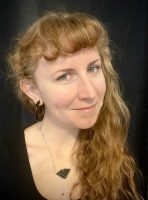
Sara Torgison is an interdisciplinary artist working in ceramic, fiber, and found materials. Her work builds into and extends finite and fragile surfaces to emphasize and inhabit marginal spaces. Strange alliances formed in passages between hard and soft substances are resonant of the shifts inherent in navigating public and private life and the distance between self and other. The action of configuring bridges in transitional zones draws upon traditions of mending and maintenance as a continuous collaborative process.
Sara received an MFA from the University of Cincinnati Department of Design, Architecture, Art and Planning, and a BFA from the California Polytechnic University, Humboldt. Sara is currently Visiting Ceramics Faculty at Miami University of Ohio, and works as a preparator at the Contemporary Arts Center in Cincinnati. She has participated in various artist residencies and workshops, including Penland School of Craft’s winter residency for which she was awarded a distinguished fellowship in 2024. Sara was a 2023 Ohio Arts Council Creative Excellence Grant recipient. Her work is widely exhibited and collected throughout the United States.
HONORABLE MENTIONS

Alex Lukas was born in Boston, MA. With a wide range of influences, Lukas’s practice is focused on the intersections of place and human activity, narrative, history, and invention. His fieldwork, research, and production reframes the monumental and the incidental through intricate publication series, sculptures, drawings, prints, videos, and audio collages. Lukas’s work has been exhibited nationally and internationally, and is included in the collections of the Pennsylvania Academy of the Fine Arts, the Kadist Foundation, the Philadelphia Museum of Art, the San Francisco Museum of Art library, the New York Public Library, and the library of the Museum of Modern Art, New York. Lukas has been awarded residencies at the Bemis Center for the Arts, the Ucross Foundation, the Center for Land Use Interpretation, the Fountainhead, and the John Michael Kohler Arts Center’s Arts/Industry program, among others. He graduated with a BFA from the Rhode Island School of Design in 2003, and received an MFA from Carnegie Mellon University in 2018. Lukas is currently an Assistant Professor of Print and Publication in the Department of Art at the University of California, Santa Barbara, and organizer of CA53776V2.gallery, an experimental exhibition platform on the dashboard of a 2007 Ford Ranger.
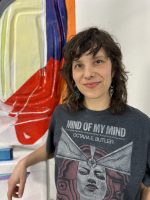
Kristy Hughes is a sculptor, painter, and educator. She received her MFA from Indiana University and her MA and BA from Eastern Illinois University. Hughes was awarded a 2022–23 Visual Arts Fellowship at the Fine Arts Work Center in Provincetown, MA, and has held residencies at the ChaNorth Artist Residency, Hambidge Center for Creative Arts and Sciences, Liquitex Residency at Residency Unlimited, the Studios at MASS MoCA, and a full fellowship at the Vermont Studio Center. Recent solo and group exhibitions include: the Sculpture Center in Cleveland, OH; Provincetown Art Association and Museum, Provincetown, MA; ChaShaMa, New York; Hudson D. Walker Gallery, Provincetown, MA; Soft Times Gallery, San Francisco, CA; Wassaic Project, Wassaic, NY, in addition to exhibitions at universities in North Carolina and South Carolina. Her work has been featured most recently in Maake magazine, New American Paintings, Friend of the Artist, Create magazine, and Vast magazine. Hughes is a full-time lecturer at the University of Vermont in Burlington, VT, where she teaches sculpture, painting, and drawing.
CAA 2023 Professional Development Fellows Announced
posted by CAA — February 05, 2024
Congratulations to our 2023 Professional Development fellows, Zoe Weldon-Yochim, University of California, Santa Cruz (Art History) and Kelly Tapia-Chuning, Cranbrook Academy of Art (Visual Art)!
Honorable Mentions: Jocelyn E. Marshall, Emerson College (Art History); Breanna Reiss, University of New Mexico (Art History); Jessica Monette, Stanford University (Visual Art).
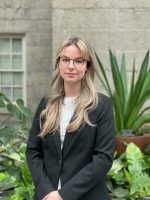
Zoe Weldon-Yochim is a PhD Candidate in Visual Studies at the University of California, Santa Cruz, whose areas of specialization include the art and visual culture of the United States, global contemporary art, and the theories and methods associated with ecocriticism. Her research involves attending to how various artists grapple with the difficulties of visuality and environmental injustices, particularly the long-term and often invisible slow violence of US militarism, nuclear toxicities, and extraction. Her dissertation, “Atomic Afterlives: Visualizing Nuclear Toxicity in Art of the United States, 1979–2011,” focuses on a selection of underrepresented American artists whose work, stemming from genealogies of research-based conceptual art and documentary practices, brings nuclear histories and concerns into aesthetic form in singular, conflictual, and shared ways. In this project, Weldon-Yochim examines how diverse visual approaches—such as installation, photography, print media, and painting—mediate, represent, and give agency to the nuclear and its atomic afterlives. Her research illuminates burgeoning artistic conceptualizations of the intersection of militarism and environmentalism during and beyond the last decade of the Cold War, where particular women, Indigenous, and Asian American artists mobilized varying visual grammar to consider the interconnectedness of environmental injustices and an ever-expanding US military system. Weldon-Yochim’s work has been supported by the American Council of Learned Societies and the Henry Luce Foundation, the Smithsonian American Art Museum, the Center for Advanced Study in the Visual Arts, and numerous university grants.
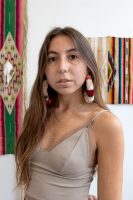
Kelly Tapia-Chuning is a mixed-race Chicana artist of Indigenous descent from southern Utah who is currently based in Detroit. Tapia-Chuning’s work forms as a response to her family’s histories of assimilation, questioning power dynamics attached to representation, racial identity, and language. Tapia-Chuning utilizes research, textile deconstruction, and needle-felting to convey the dichotomy of being nepantla, born in-between spaces and cultures.
In 2020, she received a BFA in Studio Arts from Southern Utah University and is pursuing an MFA in Fiber at Cranbrook Academy of Art, where she was awarded a Gilbert Fellowship. Tapia-Chuning’s work has been included in exhibitions at the Utah Museum of Contemporary Art, GAVLAK (Los Angeles), Onna House (East Hampton, NY), The Border Project Space (NY), and solo exhibitions with Red Arrow Gallery (Nashville, TN) and Harsh Collective (NY). She has been an artist in residence at Stove Works (Chattanooga, TN), and Zion National Park, in Utah. Tapia-Chuning’s work is in numerous public and private collections across the US.
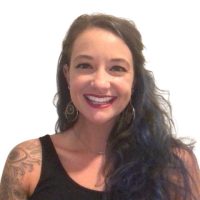
Jocelyn E. Marshall is faculty in the Departments of Visual & Media Arts and Writing, Literature, & Publishing at Emerson College. She previously was a Dissertation Scholar at Brandeis University’s Women’s Studies Research Center. Their interdisciplinary projects focus on contemporary US-based diasporic women and LGBTQ+ artists and writers, researching relationships between historical trauma and queer and feminist activism. Her work has appeared or is forthcoming in the Journal of American Culture, Women & Performance: A Journal of Feminist Theory, Public Art Dialogue, and elsewhere. In 2022, they co-edited Trauma-Informed Pedagogy: Addressing Gender-Based Violence in the Classroom, and in 2023 edited a multimedia issue of Rutgers University’s Rejoinder journal, themed Textual-Sexual-Spiritual: Artistic Practice and Other Rituals as Queer Becoming and Beyond. She also curates contemporary art exhibitions, including Being In-Between | In-Between Being (2020–21) and Creativity in the Time of Covid-19 (2023). She currently co-chairs the Gender & Feminisms Caucus at the Society for Cinema & Media Studies and is a contributing editor at Art Journal Open for the Feminist Interview Project.
Dr. Marshall’s research has been supported by, among other institutions, the Mark Diamond Research Foundation, J. Burton Harter Foundation, and New York Public Library. Her first book project draws from interviews and archival research to connect select US-based Asian and Latinx diasporic women artists as an underexamined cohort in feminist art history, contextualizing their aesthetic and poetic interventions as coterminous with shifts in US trauma studies and feminist theory. A portion of this project received Honorable Mention for the 2022 National Women’s Studies Association-Feminist Formations Paper Award.
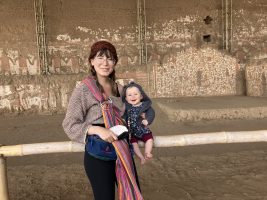 Breanna Reiss is a PhD candidate at the University of New Mexico who studies pre-Hispanic ceramics, primarily from coastal Ecuador and northern Peru, with a focus on their iconography and elements of their composition. She also received her MA from UNM where, in partnership with the Earth and Planetary Sciences Department, she examined the chemical composition of rare blue and blue-green post-fire ceramic figurine colorants from Ecuador. Her dissertation explores ancient Moche plant motifs, relating them to identifiable species and exploring their contextual relationships to narrative scenes. This plantcentric approach has identified several biomes and ecological indicators important to Moche culture. Along with teaching introductory art history courses, she has received numerous fellowships with UNM’s Center for Southwest Research and the Digital Initiatives and Scholarly Communication Department, and currently works for Georgia Tech Research Institute.
Breanna Reiss is a PhD candidate at the University of New Mexico who studies pre-Hispanic ceramics, primarily from coastal Ecuador and northern Peru, with a focus on their iconography and elements of their composition. She also received her MA from UNM where, in partnership with the Earth and Planetary Sciences Department, she examined the chemical composition of rare blue and blue-green post-fire ceramic figurine colorants from Ecuador. Her dissertation explores ancient Moche plant motifs, relating them to identifiable species and exploring their contextual relationships to narrative scenes. This plantcentric approach has identified several biomes and ecological indicators important to Moche culture. Along with teaching introductory art history courses, she has received numerous fellowships with UNM’s Center for Southwest Research and the Digital Initiatives and Scholarly Communication Department, and currently works for Georgia Tech Research Institute.
Jessica Monette is an interdisciplinary artist living in the Bay Area whose creative endeavors span the diverse realms of painting, sculpture, installation, and collage. Materiality forms the core of Monette’s artistic expression, each chosen element serving as a deliberate conduit for context and personal narrative. Her repertoire includes a wide array of materials—from house paint, plaster, and thin-set mortar to found and fabricated objects, site-specific soil, rope, nails, cotton, railroad spikes, water from the Mississippi River, and clothing collected from various family members. To New Orleans–born Monette, these materials aren’t just art components, her materials are agents for rebuilding and storytelling. The cataclysmic events of Hurricane Katrina in 2005 undergird her work and serve as a potent visual metaphor for contemporary colonial sediment, encapsulating a temporal lens that reveals the nuances of systemic oppressions. Economic inequality, gentrification, unequal aid distribution, environmental racism, forced migration, and the erosion of cultural heritage—Katrina becomes a concentrated manifestation of these issues.
Monette’s reconstruction of her familial archive, challenges systems of oppression that are created to perpetuate silence. The threads of her narrative, woven together through materials and thematic exploration, contribute to a powerful dialogue that invites viewers to reexamine the need for persistence of cultural memory and the tenacity of the human spirit.
Learn more about CAA Professional Development Fellowships here.
CWA Picks: Winter 2023/2024
posted by CAA — December 08, 2023
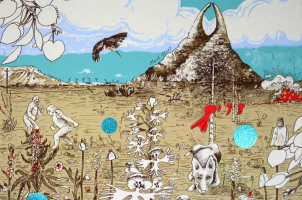
Diane O’Leary (Comanche), Watching the Weather, 1973, gouache on artist’s board, Great Plains Art Museum
The exhibitions selected for the CWA Winter Picks address issues of visibilities and invisibilities, particularly concerning artists coming from communities that have historically been marginalized for reasons that include race, ethnicity, region, religion, sexual identity, and gender. Works on view in the exhibitions on this list collectively evince a diverse set of creative practices, making visible the dynamic cultural production of groups that are often overlooked in art histories past and present. Artists represented include makers of previous eras whose works have been elided in accounts of their time periods as well as contemporary practitioners whose works grapple with continuing invisibilities—in the art world and beyond. The set of exhibitions on this Picks list underscore the critical importance of these artists and their works, insisting on their visibility.
Exhibitions have been organized by the regions where the hosting venues are located. These regions are by no means meant to be comprehensive and reflect Picks submissions by CWA members and colleagues. We are always looking to broaden the scope of these seasonal lists–please consider submitting exhibitions, lectures, grants, residencies, and other events and opportunities to future lists!
United States
Impressive: Antoinette Bouzonnet-Stella
October 21, 2023–October 20, 2024
National Museum of Women in the Arts, Washington, D.C.
Antoinette Bouzonnet-Stella’s ambitious series of 25 prints, The Entrance of the Emperor Sigismond into Mantua (engraved 1675; published 1787), reproduces an Italian Renaissance stucco frieze designed by Giulio Romano (1499 to 1546) for the Palazzo Te in Mantua. This exhibition examines the context in which Bouzonnet-Stella (1641 to 1676) created these engravings, commissioned by Jean-Baptiste Colbert, advisor to King Louis XIV. Her work at the French court was part of Colbert’s plan as vice-protecteur of the Royal Academy of Painting and Sculpture to promote a “French style,” based in classical art. Exquisitely executed, the engravings by Bouzonnet-Stella demonstrate how the power of classical art was borrowed from antiquity, employed in 16th-century Italy, and sought by the 17th-century French court
October 21, 2023–January 28, 2024
SFMOMA, San Francisco, CA
The first retrospective of Pacita Abad features more than 40 works. Over a 32-year career, the prolific artist made a vast number of artworks that traverse a diversity of subjects—from colorful masks to intricately constructed underwater scenes to abstract compositions—revealing visual, material, and conceptual concerns that still resonate today. Abad’s embrace of quilting and other kinds of needlework confounded critics, who dismissed her works as naïve, childlike, and ethnic. In fact, Abad’s multifaceted practice articulated a powerful material politics, reflecting her vision of a nonhierarchical world. This exhibition celebrates Abad’s bold self-determination, commitment to social justice, and radical artistic experimentation.
Colonial Colonnade by Doris Bittar
November 9, 2023–June 1, 2024
Arab American National Museum, Dearborn, MI
Pattern, repetition, and text are the foundation for Doris Bittar’s installation and other works in her first solo exhibition at the Arab American National Museum. Living in San Diego, Bittar draws inspiration from the Arab, Indigenous, and Latinx communities there. Colonial Colonnade is a visual, textual, aural, architectural, and cognitively rich space for interdisciplinary explorations of the Arabic language. In this site-specific installation, Bittar explores how colonization has affected language, among other aspects of culture, while creating a space for reflection and free movement.
Marta Minujín: Arte! Arte! Arte!
November 17, 2023–March 31, 2024
The Jewish Museum, NYC
Marta Minujín: Arte! Arte! Arte! Is the first survey exhibition in the United States of Marta Minujín, a defining force of Latin American art whose trajectory intersected with the major artistic developments of the postwar period. Arte! Arte! Arte! includes nearly 100 works organized to reflect Minujín’s bold experimentation over six decades, charting Minujín’s influential career in Buenos Aires, Paris, New York, and Washington, DC. Works include her pioneering, mattress-based soft sculptures; fluorescent large-scale paintings; psychedelic drawings and performances; and vintage film footage. Ephemeral works—happenings, participatory installations, and monumental public art—are presented through rarely seen photographs, video, and other documentation.
January 27–March 16, 2024
The Galleries at Moore College of Art and Design, Philadelphia, PA
(Re)FOCUS: Then and Now is an exhibition in two parts that aims to celebrate a historically significant 1974 feminist show that was called FOCUS by 1) bringing artworks created by the original 81 participating artists together in one space and 2) presenting new & recent work/s by Philadelphia-based artists who are exploring ideas of gender identity, representation, marginalization, social justice, violence, equality, and empowerment in their contemporary studio practices.
Taking Space: Contemporary Women Artists and the Politics of Scale
September 15, 2023–January 7, 2024
Montclair Art Museum, Montclair, NJ
Taking Space: Contemporary Women Artists and the Politics of Scale invites viewers to consider how space, size, scale, and repetition can be interpreted as political gestures in the practices of many women artists. Inspired by a 2021 exhibition at the Pennsylvania Academy of the Fine Arts (PAFA), Taking Space features 10 works from that original show alongside 13 works from the collection of the Montclair Art Museum. Together these works reveal the varied approaches of women artists for whom space is a critical feature of their work.
October 12, 2023–January 14, 2024
New Museum, NYC
Judy Chicago: Herstory spans Judy Chicago’s sixty-year career to encompass the full breadth of the artist’s contributions across painting, sculpture, installation, drawing, textiles, photography, stained glass, needlework, and printmaking. Expanding the boundaries of a traditional museum survey, the exhibition places six decades of Chicago’s work in dialogue with work by other women across centuries in a unique Fourth Floor installation. Entitled The City of Ladies, this exhibition-within-the-exhibition features artworks and archival materials from over eighty artists, writers, and thinkers.
Fruits of Labor– Reframing Motherhood and Artmaking
November 3–December 23, 2023
apexart, NYC
Fruits of Labor– Reframing Motherhood and Artmaking brings together women artists unpacking the vastly personal yet universal experience of mothering. Encompassing painting, sculpture, video, installation, photography and text-based work, the exhibition evokes motherhood thematically, but also explores the countless tangential ways in which this subject appears in artists’ practice, as a mode of work and being. The artists ultimately make a compelling argument: it is not motherhood that is in conflict with artmaking but the prevailing narratives defining both caregiving and artistic expression.
Making Her Mark: A History of Women Artists in Europe, 1400-1800
October 1, 2023–January 7, 2024
Baltimore Museum of Art, Baltimore, MD
Making Her Mark: A History of Women Artists in Europe, 1400-1800 aims to correct the broadly held but mistaken belief that women artists in Europe were rare and less talented than their male counterparts. With over 200 works, from royal portraits and devotional sculptures to embroidered objects, tapestries, costumes, wax sculptures, metalwork, ceramics, graphic arts, furniture, and more, Making Her Mark features objects from the 15th to 18th centuries that reflect the multifaceted and often overlooked ways that women contributed to the visual arts of Europe.
May 27, 2023–January 1, 2024
National Museum of the American Indian, Bowling Green, NY
Shelley Niro: 500 Year Itch is the first major retrospective of Shelley Niro’s paintings, photographs, mixed-media works, and films. Accessible, humorous, and peppered with references to popular culture, Niro’s art delves into the timeless cultural knowledge and generational histories of her Six Nations Kanyen’kehá:ka (Mohawk) community; addresses stereotypes associated with Native people, particularly women; and ultimately provides purpose and healing.
Raven Halfmoon: Flags of Our Mothers
June 25, 2023–January 7, 2024
The Aldrich Contemporary Art Museum, Ridgefield, CT
Working mainly in portraiture, Caddo Nation painter and sculptor Raven Halfmoon fuses Caddo pottery traditions (a history of making mostly done by women) with populist gestures—often tagging her work (a reference to Caddo tattooing). Her palette is specific and matches both the clay bodies she selects and the glazes she fires with—reds (after the Oklahoma soil and the blood of murdered Indigenous women), blacks (referencing the natural clay native to the Red River), and creams. Her works reference stories of the Caddo Nation, specifically her feminist lineage and the power of its complexities.
No Rest: The Epidemic of Stolen Indigenous Women, Girls, and 2Spirits
January 12, 2023–Extended through 2024
Mitchell Museum of the American Indian, Evanston, IL
The exhibition features 35 original works from 12 collaborating Indigenous artists and draws attention to the crimes perpetrated against Native women and two-spirit individuals in the United States. Rather than present the impacted individuals and communities as statistics, the Mitchell Museum employs an interdisciplinary approach that includes visual stories, interactive content, educational programming, community events, and an awareness campaign to humanize and honor the lives of Indigenous women and two-spirit individuals.
From Paintbrushes to Camera Lenses: Creative Women of the Great Plains, Part II
July 25–December 16, 2023
Great Plains Art Museum, Lincoln, NE
In fall 2018, the Great Plains Art Museum mounted From Paintbrushes to Camera Lenses: Creative Women of the Great Plains, an exhibition that highlighted exceptional work created by female artists from the museum’s permanent collection. To complement other female-focused exhibitions on view during fall 2023 (see below), the museum is organizing part two of this exhibition to showcase many recent acquisitions and other works from the collection by women that were not shown in the first installation.
Supporting Indigenous Sisters: An International Print Exchange
July 25–December 16, 2023
Great Plains Art Museum, Lincoln, NE
Supporting Indigenous Sisters is a print portfolio exchange involving sixteen artists from both Indigenous and non-Indigenous backgrounds. The portfolio was created to help begin conversations on many levels about missing and murdered Indigenous women. Each artist was asked to reach into their own experiences as a female walking this earth. The images from all of the artists advocate for change and for voicing this dark present history.
Threads & Trails: Contemplations of Our Herstories
July 25–December 16, 2023
Great Plains Art Museum, Lincoln, NE
Threads & Trails: Contemplations of Our Herstories is a collaborative exhibition created by five female-identifying artists who connect their personal histories to the conquest of the American West and Indigenous dispossession.
November 3–December 23, 2023
DOCUMENT, Chicago, IL
Natani Notah is a Diné (Navajo) interdisciplinary artist whose practice explores contemporary Native American existence through the lens of Indigenous Feminism. In Thoughts on Being Thrown, Notah connects maps, bodies, and objects to reflect on the larger social issues that repeatedly intersect the lives of women and men alike.
Form, Growth, and Variation: The Experimental Prints of Helen Phillips
November 16, 2023–February 24, 2024
Wright Museum of Art, Beloit College, Beloit, WI
California-born sculptress Helen Phillips found printmaking in the 1930s at Stanley William Hayter’s Atelier 17 in Paris. Though she remained primarily a sculptor, this exhibition chronicles her body of intaglio work—and it is the first solo exhibition of Phillips’s work in the US. From her early, transformative years in Paris, through her move to New York in 1940—when she became a mother—and back to Paris in the 1950s where she produced daring work in color, the prints showcase the artist’s constant affinity to three dimensions, growth in printmaking, and experimentation in line and color.
Nancy Baker Cahill: Through Lines
October 28, 2023–May 19, 2024
Georgia Museum of Art at the University of Georgia, Athens, GA
This solo exhibition highlights the artist’s interdisciplinary artistic practice and the role of emerging technologies in contemporary art. This mid-career survey exhibition is Baker Cahill’s first solo museum show. Expanding upon her background in traditional media, the artist redefines the possibilities of drawing in contemporary art by using augmented reality to transform her graphite-on-paper drawings into immersive environments.
Public Works: Art by Elizabeth Olds
February 3–July 14, 2024
Harry Ransom Center, University of Texas at Austin, Austin, TX
Elizabeth Olds portrayed Depression-era conditions in the United States and was part of a group that promoted the affordability and accessibility of silkscreen printing. This first critically-engaged solo exhibition of her work considers Olds’s lifelong advocacy—from her depictions of labor conditions in the US mining and meatpacking industries, to her satirical social commentary, to her illustrated books for children.
Jen Everett: Could you dim the lights?
February 1–October 5, 2024
Krannert Art Museum, University of Illinois, Champaign, IL
Artist and educator Jen Everett remixes images of herself in conversation with materials she collects to talk about Black life, kinship, and collective gathering. Could you dim the lights? at Krannert Art Museum is her first solo museum presentation. Revisiting childhood photographs, Everett deeply engages rupture—upheaval too familiar in Black life—and recognizes the private, intimate aspects of vernacular images, creatively negotiating ways to maintain their insistent, quiet power. The show is comprised of photographs, moving images, and sound. Inspired partly by her 2022 residency on Fire Island, the exhibition surfaces Black lesbians and queer presence in Black vernacular archives.
Sketch: Contemporary Artists in Conversation with Emily Grace Hanks
October 25–December 6, 2023
Doris Ulmann Galleries at Berea College, Berea, KY
In the summer of 2023, Sara Olshansky and Esther Sitver partook in a residency at the Doris Ulmann Galleries during which they studied the work and personal papers of Emily Grace Hanks (American, 1886-1962) housed in the Berea College Art Collection—and then created a series of artworks in response to what they found. Seeking to “activate” Hanks’ historical artworks for a contemporary, largely undergraduate audience, this exhibition explores the connections that can be made between artists across time and raises questions about what it means to leave an artistic “legacy.” What can we find when we look to the past? What can an archive reveal… and what does it leave obscured? And how can we fill in the gaps?
Deborah Butterfield: P.S. These are not horses
October 1, 2023–June 24, 2024
Jan Shrem and Maria Manetti Shrem Museum of Art at University of California, Davis, CA
For more than 50 years, Deborah Butterfield has explored the horse—both its form and presence. And yet, P.S. These are not horses encourages viewers to understand her sculpture as more than representations of the equine world. Taken from the closing line of a poem by Butterfield’s mentor, William T. Wiley, the title emphasizes the sculptor’s commitment to abstraction and her profound investment in material experimentation. The exhibition surveys Butterfield’s career from her most recent wildfire sculptures to rare early works including ceramics made while studying at UC Davis.
Shiva Ahmadi: Strands of Resilience
January 28–May 6, 2024
Jan Shrem and Maria Manetti Shrem Museum of Art at University of California, Davis, CA
Shiva Ahmadi uses painting as a form of storytelling, combining luminous colors and mystical beings with violent imagery to draw attention to global issues of migration, war, and brutality against marginalized peoples. Ahmadi’s first solo museum exhibition on the West Coast of new works continues her exploration of alternate worlds where women have agency beyond the binary of the beautiful victim or ugly villain. Through her experimentation with the medium of watercolor, Ahmadi probes what lies hidden beneath the surface of the stories we are told, from ancient myths and childhood memories to the modern news cycle.
Samia Halaby: Centers of Energy
February 10–June 9, 2024
Sidney and Louis Eskenazi Museum of Art, Indiana University, Bloomington, IN
Samia Halaby is a pioneer in twentieth-century abstraction and computer-generated art. Born in Jerusalem, Halaby trained as a painter, earning an MFA at Indiana University, where she joined the faculty before becoming the first woman associate professor at the Yale School of Art. This exhibition is her first American survey, featuring more than forty paintings, prints, drawings, and computer-generated works of art from across six decades. The exhibition presents a chronological development of her artistic approach to abstraction, examining formal and thematic relationships across bodies of work.
Yvette Molina: A Promise to the Leaves
October 21, 2023–September 7, 2025
Frances Young Tang Teaching Museum and Art Gallery at Skidmore College, Saratoga Springs, NY
Yvette Molina: A Promise to the Leaves transforms the mezzanine into a museum community space with new art and designs in a site-specific and evolving installation centered around the four elements—earth, air, water, fire—and a fifth constituent, the cosmos. Molina encourages us to consider care as entangled within circles of life—care for one another, whether human or non-human, is care for ourselves and for all. Throughout the exhibition’s two years, Molina is inviting other artists to present their work in the space, regularly re-energizing the installation’s balance between comfort and provocation.
Mary Bauermeister: Fuck the System
November 11, 2023–January 20, 2024
Michael Rosenfeld Gallery, NYC
Mary Bauermeister: Fuck the System is a memorial exhibition and the first solo show to open since the artist’s death in March 2023. It surveys the diverse, interdisciplinary oeuvre of Bauermeister’s seven-decade career. A child of totalitarian Germany who rejected the Constructivist mandates of the country’s postwar schools of art and design, Bauermeister’s art and worldview were always explicitly anti-tradition. Taking its title from a significant assemblage piece, Fuck the System features works from each of her major series. The artist’s fascination with paradox and its potential to reveal fissures in the foundations of entrenched conventions is apparent throughout her work, which both embodies and challenges contradictory binaries.
Ubuhle Women: Beadwork and the Art of Independence
October 4, 2023–January 11, 2024
Godwin-Ternbach Museum at Queens College, CUNY, Flushing, NY
Godwin-Ternbach Museum is pleased to announce Ubuhle Women: Beadwork and the Art of Independence, a spectacular overview of a new form of bead art, the ndwango (“cloth”), developed by by women with a shared vision working together in KwaZulu-Natal, South Africa. The plain black fabric that serves as a foundation for the Ubuhle women’s exquisite beadwork is reminiscent of the Xhosa headscarves and skirts that many of them wore growing up. By stretching this textile like a canvas, the artists use colored Czech glass beads to transform the flat cloth into a contemporary art form of remarkable visual depth. Using skills handed down through generations and working in their own unique style “directly from the soul” (in the words of artist Ntombephi Ntobela), the women create abstract as well as figurative subjects for their ndwangos.
Out of Bounds: Japanese Women Artists in Fluxus
October 13, 2023—January 21, 2024
Japan Society Gallery, New York
This exhibition will be the first to fully explore the essential role of Japanese women in Fluxus, a movement instigated in the 1960s that helped contemporary artists define new modes of artistic expression. Near the 60th anniversary of the movement’s founding, this exhibition highlights the contributions of four pioneering Japanese artists — Shigeko Kubota (1937–2015), Yoko Ono (1933–), Takako Saito (1929–), and Mieko Shiomi (1938–) — and contextualizes their role within Fluxus and the broader artistic movements of the 1960s and beyond.
The exhibition is organized by Midori Yoshimoto, Guest Curator, and Tiffany Lambert, Curator and Interim Director, Japan Society, with Ayaka Iida, Assistant Curator, Japan Society.
Canada
Being and Belonging: Contemporary Women Artists from the Islamic World and Beyond
July 1, 2023–January 7, 2024
Royal Ontario Museum, Toronto, ON
Being and Belonging: Contemporary Women Artists from the Islamic World and Beyond is a bold exhibition exploring the defining issues of our time from the perspective of 25 women artists from or connected to the broader Islamic world spanning across West Africa to Southeast Asia or living in diaspora. Deftly interrogating themes of identity, power, sexuality, and home, this exhibition resists simple stereotypes with outstanding artworks from both emerging and well-established artists.
Swapnaa Tamhane: No Surface is Neutral
September 23–November 26, 2023
Surrey Art Gallery, Surrey, BC
Swapnaa Tamhane’s work challenges the colonial hierarchical separation between art, craft, and design in India. Her artworks include sweeping textile installations where space is transformed by fabric, colour, and light, and works on handmade paper.
Diaspora Dialogues: Archiving the Familiar
October 4, 2023–December 2, 2023
Sur Gallery, Toronto, ON
This exhibition establishes an ongoing dialogue with Latin American diaspora women who are working within the Canadian settler-nation-state, using archives as a strategy of inquiry and resistance. Through dialogic meaning-making processes, these artworks highlight how our social, and political situatedness in the world intersects with memory and power. The artworks in Diaspora Dialogues make visible the living political memory of the diaspora through diverse media art languages, manifesting affective approaches to the archive as a site of interpretation, contestation, and negotiation.
Mexico
Coordenadas móviles: Redes de colaboración entre mujeres en la cultura y el arte (1975-1985)
September 30, 2023–January 14, 2024
Museo de Arte Carrillo Gil, Mexico
This exhibition responds to the urgency of developing new methodologies to rethink the history of recent art in Mexico and the place of women in it. The focus is on collaborative networks that built a creative field forged in differences, dialogue, conflict, complicity, vulnerability, rumor, secrecy, silences, frustration, and friendship, particularly between the years 1975 and 1985. Coordenadas móviles gathers research based on conversations with artists and the study of archives and personal and institutional collections in the country. It also includes commissioned pieces that perform contemporary readings of some historical materials.
Poéticas feministas: Ana Victoria Jiménez / Alicia D’Amico
November 30, 2023–February 11, 2024
Museo de Arte Moderno, Mexico
The exhibition puts in dialogue the documentary and artistic work of photographers Victoria Jiménez and Alicia D’Amico, protagonists of the feminist movement in their respective countries—Mexico and Argentina—who, through a look that ranges from the intimate and poetic to the social, incorporated into their photographic work their social commitment with a feminist aesthetic. The exhibition shows the scope and contacts between Latin American women’s movements, while at the same time situating the trajectory of these two artists in the context of Latin American art.
Europe + The UK
September 16, 2023–January 18, 2024
CO Berlin, Berlin, Germany
Since the 1960s, the US documentarian and portraitist Mary Ellen Mark has advocated for people on the fringes of society. This show features five iconic projects created by the photographer in the 1970s and 1980s. Ward 81 collects her documentation of women in a state mental institution in Oregon, Falkland Road is a reportage on sex workers in Mumbai, Mother Teresa’s Missions of Charity is an eponymous exploration both of the woman and her mission, Indian Circus reproduces a series depicting traveling circus families, and Mark’s award-winning Streetwise project and subsequent Tiny: Streetwise Revisited show her ongoing commitment to telling the story of Erin Charles.
Women In Revolt! Art and Activism in the UK 1970-1990
November 8, 2023–April 7, 2024
Tate Britain, London, UK
This exhibition is the first of its kind – a major survey of feminist art by over 100 women artists working in the UK between 1970 and 1990. It explores how networks of women used radical ideas and rebellious methods to make an invaluable contribution to British culture. Through their creative practices, women’s liberation was forged against the backdrop of extreme social, economic and political change.
September 20, 2023–January 22, 2024
Pinault Collection, Paris, France
This exhibition at the Pinault Collection in France features works on rice paper made by noted feminist artist Mira Schor in the second half of the 1970s, along with a recent painting made in 2022. With a fragile, solitary presence, masks and dresses are covered with highly personal, handwritten texts about the artist’s dreams and her interpretations of them, along with reflections on the Holocaust, to which she lost some of her family, and political writings. “In these works on paper, all that remains of the body are traces of its active, thoughtful character: writing,” notes Schor, “which thus complicates women’s legibility.”
MIDDLE EAST
Afra Al Dhaheri – Give Your Weight to the Ground
November 14, 2023–January 5, 2024
Green Art Gallery, Dubai
This solo exhibition of Afra Al Dhaheri’s work focuses on the concept of grounding: slowing down and observing; becoming conscious of our surroundings; and absorbing and processing. The exhibition is the accumulation of material language developed over time through practice and inquiry. It is layered with the artist’s research into the relation between materiality and the body (a tangible construct), as well as with labour, time, inherited ideologies, and the study of inhabited spaces (intangible constructs).
Roshanak Aminelahi: Faces of Resilience
November 14, 2023–January 2, 2024
Ayyam Gallery, Dubai
In this solo show, Iranian artist Roshanak Aminelahi illuminates diverse stories of women who navigated a male-dominated society and persevered through adversity. Using pointillism and color-blocking techniques, Roshanak captures the distinctive features of these remarkable women. Despite the faceless portrayal, the women are still identifiable, and the portraits symbolize feminine energy and stand as a testament to societal advancement forged through years of resilience and fight for equality by women worldwide.
Apply for Student Travel to Special Exhibitions
posted by CAA — November 07, 2023
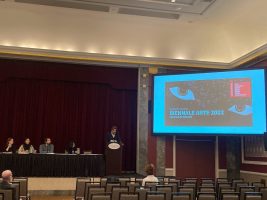
Christopher Heuer and students from the course Pilgrimage/Exhibition/Biennale discussing their experience at the Venice Biennale during the CAA Annual Conference 2023 in New York, NY.
In fall 2018, we announced CAA had received an anonymous gift of $1 million to fund travel for art history faculty and their students to special exhibitions related to their classwork. The generous gift established the Art History Fund for Travel to Special Exhibitions. We are happy to accept new applications again for this upcoming year.
The fund is designed to award up to $10,000 to qualifying undergraduate and graduate art history classes to cover students’ and instructors’ costs (travel, accommodations, and admissions fees) associated with attending museum special exhibitions throughout the United States and worldwide. The purpose of the grants is to enhance students’ first-hand knowledge of original works of art. Interested members can also see recent awardees share their experiences at the session at the CAA Annual Conference.
Applications are due by January 15, 2024.
caa.reviews Seeks Field Editors in Eleven Areas
posted by CAA — March 21, 2023
CAA is inviting nominations and self-nominations for individuals to join the caa.reviews Council of Field Editors for the three-year term July 1, 2023–June 30, 2026. An online journal, caa.reviews is devoted to the peer review of new books, museum exhibitions, and projects relevant to art history, visual studies, and the arts. Candidates may be artists, art historians, art critics, art educators, curators, or other art professionals with stature in the field and experience writing or editing books and/or exhibition reviews; institutional affiliation is not required.
-
-
- Indigenous Art
- Architectural History, Urban Planning, Historic Preservation, Landscape Architecture
- South and Southeast Asian Art
- Islamic Art
- Cinema, Media, and Performance
- Nineteenth-Century Art
- Twentieth-Century Art
- Contemporary Art
- Early Modern European Art (South)
- Exhibitions: Midwest
- Exhibitions: Northeast
-
Working with the caa.reviews editor-in-chief, the caa.reviews Editorial Board, and CAA’s staff editor, each field editor selects content to be reviewed, commissions reviewers, and considers manuscripts for publication. Field editors for books are expected to keep abreast of newly published and important books and related media in their fields of expertise, and those for exhibitions should be aware of current and upcoming exhibitions (and other related projects) in their geographic regions.
The Council of Field Editors meets once a year at the CAA Annual Conference. Members of all CAA committees and editorial boards volunteer their services without compensation.
Candidates must be current CAA members and should not be serving on the editorial board of a competing journal or on another CAA editorial board or committee. Nominators should ascertain their nominee’s willingness to serve before submitting a name; self-nominations are also welcome.
Interested applicants—both self-nominated or nominated by someone else—should submit a CV and a cover letter, in one PDF document to ebell@collegeart.org.
Deadline: April 30, 2023
caa.reviews Seeks Board Member
posted by CAA — March 21, 2023
**THESE POSITIONS HAVE BEEN FILLED. NOMINATIONS ARE CLOSED**
caa.reviews seeks a new Editorial Board Member to fill the post of Emerging Professional, defined as an active member of CAA who is in graduate school or in the first two (2) years of their career. The Emerging Professional will serve a four-year term, July 1, 2023–June 30, 2027.
CAA encourages applications from candidates with a strong record of scholarship who are committed to the imaginative development of caa.reviews. An online journal, caa.reviews is devoted to the peer review of recent books, museum exhibitions, and projects relevant to the fields of art history, visual studies, and the arts.
The editorial board advises the editor-in-chief and field editors for the journal and helps them to identify books and exhibitions for review and to solicit reviewers, articles, and other content for the journal. The editorial board guides the journal’s editorial program and may propose new initiatives for it. Members stay abreast of trends and issues in the field by attending and reporting on sessions at the CAA Annual Conference and academic conferences, symposia, and other events in their fields.
The caa.reviews Editorial Board meets three times a year, twice in the spring and fall and once at the CAA Annual Conference in February. Members also attend the annual meeting of the caa.reviews Council of Field Editors at the Annual Conference. Members pay their travel and lodging expenses to attend the meeting at the conference. Meetings in the spring and fall are currently held by teleconference. Members of all editorial boards volunteer their services to CAA without compensation.
Candidates must be current CAA members and should not currently serve on the editorial board of a competitive journal or another CAA editorial board or committee. Nominators should ascertain their nominee’s willingness to serve before submitting a name; self-nominations are also welcome. Please email a statement describing your interest in and qualifications for appointment, a CV, and your contact information to Eugenia Bell, Editorial Director, ebell@collegeart.org. Please include the subject line caa.reviews Emerging Professional.
Deadline: April 30, 2023; finalists will be interviewed in early May.
CAA Staff Spotlight: Mira Friedlaender
posted by CAA — March 10, 2023
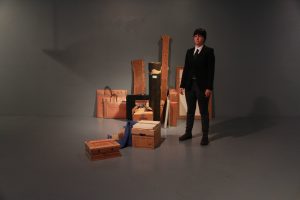
On Guard, performance centering on the installation of long-stored objects from the Bilge Civelekoglu Friedlaender Estate, FiveMyles, Brooklyn, 2014.
Mira Friedlaender is CAA’s Senior Manager of Annual Conference and Programs. Since joining CAA in 2018, Mira has worked with a significant portion of members (new and returning!) and continues to do so each year to support their participation in conference sessions and events. She produces the event with CAA staff, committees, and partners, attending to myriad details while also working to refine and reshape the conference each year in support of CAA’s long-term strategic goals. Mira was previously an exhibition manager for nonprofits such as No Longer Empty and HappyLuckyNo1. She also worked in television production and co-owned a restaurant in Brooklyn, New York.
As an artist and independent scholar of art stewardship, Mira has exhibited locally and internationally, and her work has been featured in the New York Times and Bomb. She has held residencies at the American Center in Bangladesh and Recess in New York. She is the Director of the Bilge Friedlaender Estate, was a fellow in the Art & Law Program, and cocurated Bilge Friedlaender: Words, Numbers, Lines in Istanbul.
“Since her death, I’ve been stewarding the art my mother Bilge Friedlaender (née Civelekoglu) made, beginning more actively in 2014 with my project at Recess, which was still in Soho at that time. I’ve contributed to the scholarship on artist estates through this work and through knowledge sharing; as an artist and artist’s heir I am most interested in performing an emotional institutional critique of the challenges artist-stewards face, particularly those without infinite resources,” explains Mira.
Curated by Işın Önol, Bilge Friedlaender’s never-before-seen works from the 1970s are on view now at Sapar Contemporary in New York City through April 10. Bilge’s work occupies a unique place in the Turkish and Middle Eastern modernist tradition as well as in the history of twentieth-century American art, especially the soulful minimalism of 1970s—not unlike the work of Zarina Hashmi, Etel Adnan, and Huguette Caland. Bilgé’s minimalism is infused with Sufi mysticism, sacred numerology, and reverence for nature and the divine feminine. Her spiritual feminism evolved into an overt ecofeminism as she grew older.
“My mother left Turkey in 1958 to come to the US and be an artist, and she exhibited until her death. Since 2015 there has been a museum show of her work in Istanbul and there have been subsequent opportunities for Bilge’s work, but this is the first time her work has been shown in New York City since 1981. This is a big step for the estate. Next, we are looking to travel this incredible selection of the works on paper and artist books with the goal of expanding the scholarship around Bilge’s artworks and extensive writings.”
Join Mira and curator Işın Önol in conversation with guests on April 4, 6 p.m. ET, at Sapar Contemporary.
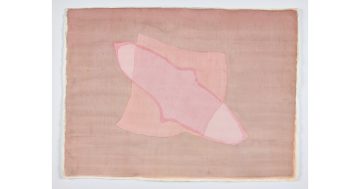
Bilge Friedlaender, Weightless Pink, 1975
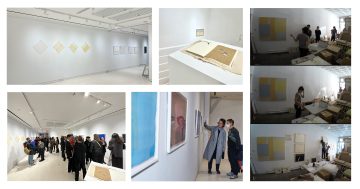
Bilgé: Lifespan of a Horizontal Line, Sapar Contemporary, 2023, and, right column, Half of What’s There, Recess Art, 2014
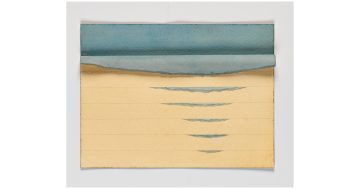
Bilge Friedlaender, Tides Time II, 1975



